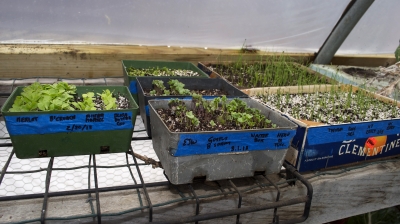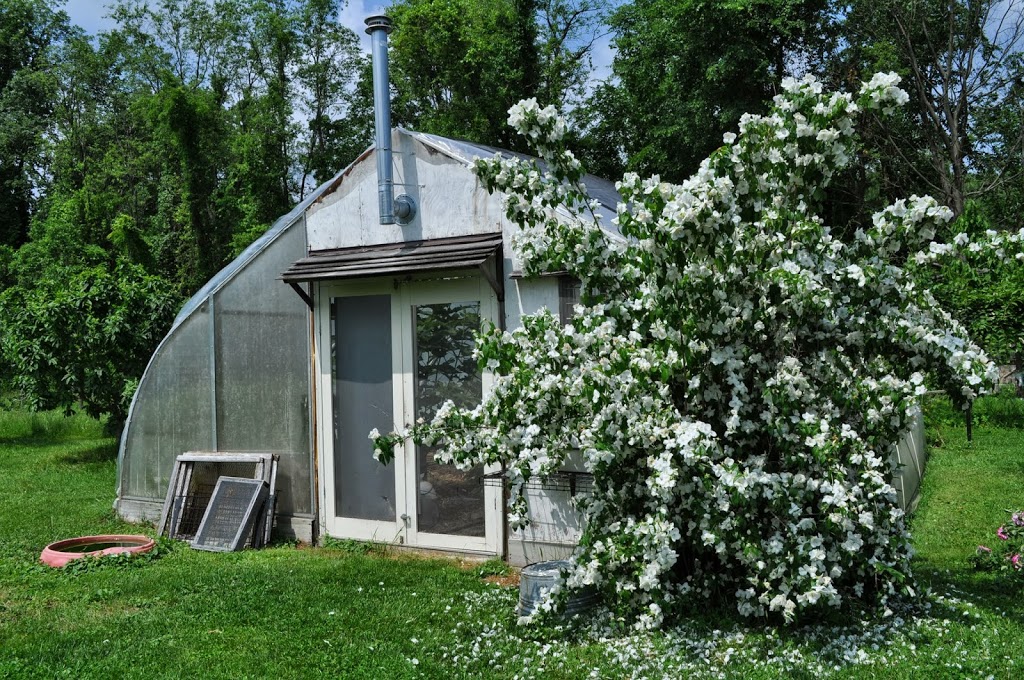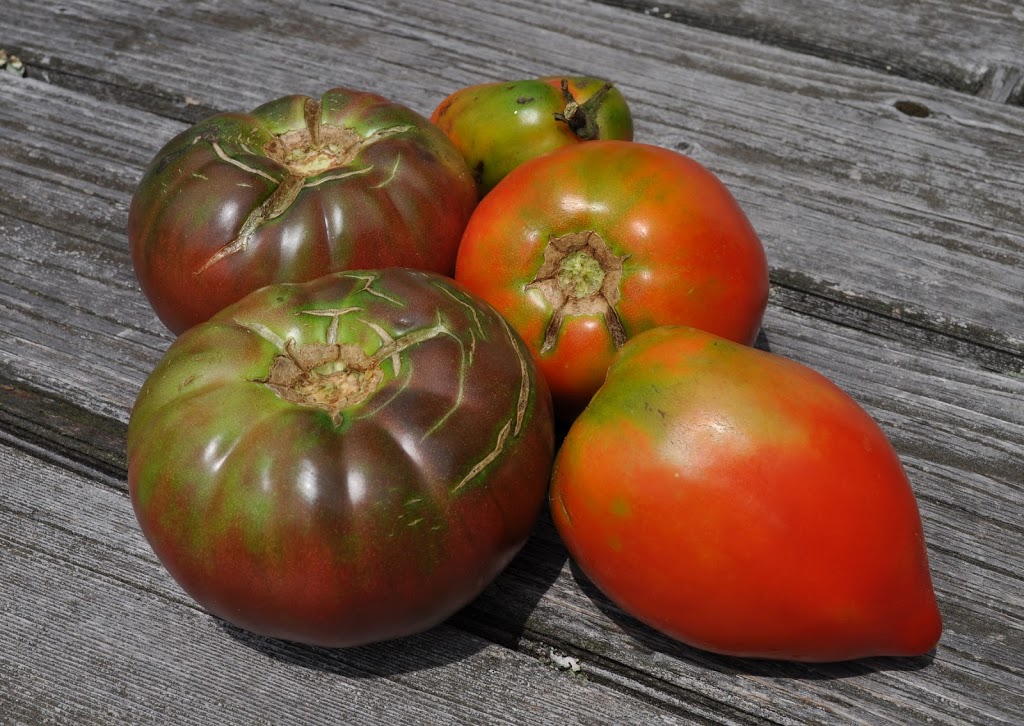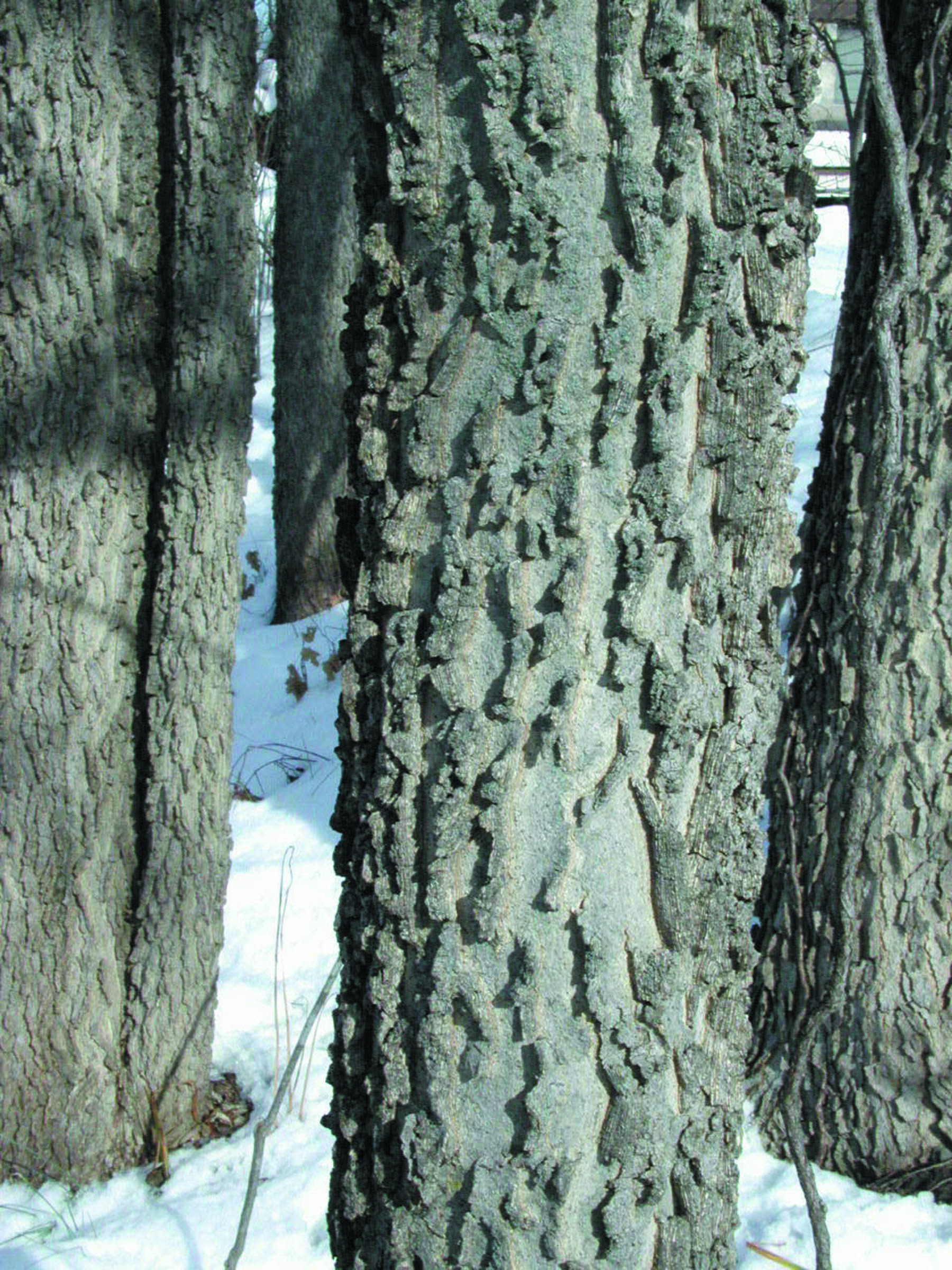SOW A (FIGURATIVE) SEED
An Oasis
It’s not the time of year to inspire most of us gardeners to sow a seed, but sow I will, a figurative seed in your imagination. Who knows what reality it may grow into?
As the weather turns increasingly cool, then cold, and the landscape becomes washed over in gray and brown, imagine a retreat, an oasis of lush greenery and bright colored flowers suffused in warm, moist air. A greenhouse.

Greenhouse at the Nearing’s Forest Farm
Home or “hobby” greenhouses run the gamut from lavish, Victorian-style conservatories to primitive structures cobbled together from discarded window frames.
No need for snobbery, though: Each of these structures, and everything in between, creates its own oasis. Even the coldframe I once made, which was nothing more than an 6 x 6 foot wooden box with a sloping roof and a clear plastic cover, hinted of the tropics each time its cover was opened.

Reality
I almost began this next paragraph with the sentence: “A first step on the road toward creating your own oasis is thinking about just what you want out of a greenhouse.” Then I realized its folly. What I would want, as would most other gardeners, even nongardeners, would be a spacious conservatory. Said conservatory would be cozy for its abundance of lush, tropical greenery, with enough space carved out amongst the arching fronds of a banana plant and fragrant citrus blossoms to accommodate a small dining table and chairs. No matter if the scene is white with snow outdoors; inside is tropical warmth.
Let’s float back down to reality. The above greenhouse is beyond many a gardener’s budget, and justification for heating a space enough to keep tropical plants happy in cold winter climates is questionable environmentally. Fuel needs rise dramatically with each degree greenhouse temperature is ratcheted up. Then again, newer greenhouse coverings, coupled with innovative methods of storing excess heat generated on sunny days, can go a long way to dampening heat losses.
Among those innovative heating methods are various ways of tapping into the year-round ground temperature, which hovers in the mid-50s a few feet below ground, for heating in winter and cooling in summer. (See, for example, “Greenhouse in the Snow” on youtube.) Or phase changing salts that efficiently store heat on sunny days, to be release on cold nights. Or something as simple as dark barrels filled with water (which do, admittedly, use valuable greenhouse real estate.)
Free-standing or Attached
Before letting your imagination trail too far, though, in how large a greenhouse you would like and how warm you would like to keep it, consider whether you’d prefer the structure to be free-standing or attached to your home. A free-standing structure offers the most flexibility in design and siting, and is bathed in light from all four sides. Also, there’s no need to integrate it with house design, or for it to look anything prettier than just functional.
The attached greenhouse requires more thought as to style, and does have some advantages. Cozied up against a home, an attached greenhouse loses less heat. It can tap the heat storing capacity of the home’s wall where it is attached, especially if that wall is masonry, even tap into your home’s heating system. On sunny winter days, excess heat generated in the greenhouse can be vented into your home. That moist heat is a lot more comfortable than the dry heat of home heating systems, although some caution is needed against venting too much moisture into your home and causing mold.
Getting back to that table and chairs that might squeeze their way into your greenhouse: How likely are you to schlepp brunch across the snow to your free-standing greenhouse some sunny, winter morning? If you have a wall facing in a direction that gets enough light for the plants that you want to grow, the attached greenhouse is the one most likely to provide living space in additional to functional space.
The easiest decisions to make in growing a greenhouse are whether it is to be free-standing or attached, its size, and what plants it will house, which determines heating needs. No need to get into other details just yet. Let your imagination, slightly more grounded, roam. After all, only a seed has been sown.
I labored for too many years trying to figure out ways to integrate an attached greenhouse into the look of my home. That laboring was cut short when a farmer friend got an economical deal on heavy duty metal pipes for greenhouse trusses and purloins. They were all straight, though. No problem, because Ron had made a giant jig to lay on the ground around which to bend the pipes with the pull of a tractor. It was an offer I couldn’t refuse.

My greenhouse
So I had parts for a 20 x 20 foot greenhouse. By September I had a freestanding greenhouse, ready for planting.
My Dream, My Reality
My plan was, and still is, to heat the greenhouse minimally — just enough (about 35 degrees F) to keep a winter’s worth of lettuce, kale, celery, mâche, scallions, arugula, and mustard greens growing for salads.
Hmmm, I thought. How about a shelf on which to raise spring seedlings?

Hmm, I thought again, temperatures dipping into the 30s in winter are just what’s needed to keep figs — subtropical, not tropical plants — happy, dormant, and leafless while all those salad greens are growing in the beds below. So into the ground at the head of each vegetable bed went three fig trees, San Piero, Brown Turkey, and Bethlehem Black. Near the center of the end wall went Rabbi Samuel (a made up name). 
 Although I had gardened for decades, I had to learn how to do so in a greenhouse. That was mostly with respect to timing plantings early enough to provide a steady stream of harvest through winter but not so early that lettuce, spinach, and other cool weather crops go to seed before being ready for harvest.
Although I had gardened for decades, I had to learn how to do so in a greenhouse. That was mostly with respect to timing plantings early enough to provide a steady stream of harvest through winter but not so early that lettuce, spinach, and other cool weather crops go to seed before being ready for harvest.  With good timing as far as sowing and moving trays outdoors at a date appropriate for each seedling, the 15 x 3 foot seedling shelf provides all plants needed for 2000 square feet of outdoor vegetables.
With good timing as far as sowing and moving trays outdoors at a date appropriate for each seedling, the 15 x 3 foot seedling shelf provides all plants needed for 2000 square feet of outdoor vegetables.
In recent years, I’ve taken advantage of the early spring warming and summer heat in the greenhouse for growing earlier cucumbers and ginger root. Protection from winter cold and native pests has a pure vinifera grape, Perle de Csaba, dripping with bunches of sweet, flavorful, seedless grapes beginning in mid-July and continuing for more that a month. 
There were a few failures also: pomegranates and loquats, for instance, and Bethlehem Black fig was replaced by Katoda, in turn replaced by Excel.
It’s all still a learning experience, getting better every year.







Thanks for sharing your greenhouse experiences, Lee.
I was blessed several years ago with a free used greenhouse. I love it for starting seeds and fresh winter greens. It’s certainly a challenge to get the timing right. I try to maintain the temperature in the 40’s, but that’s another challenge. Last year we provided supplemental lighting with inexpensive LED lights, and the aphid population exploded. No luck yet, either, with ‘greenhouse’ cucumbers – not enough air circulation is my guess. BUT, despite the challenges, I keep trying new ideas. RIght now, there are two pots of ‘Apero’ cherry tomatoes, started outdoors in August, that should ripen soon – fingers crossed!
In my experience, tomatoes ripening in weather that’s too cool just don’t taste that good. I stick sticks with nice heads of lettuce, scallions, etc.
You inspired me to go clean up my 2 greenhouses. One I “put away” for the winter, the other I cleanup up and got it ready to start some winter veggies! I live in zone 6b in far eastern Washington, so my winter crop will be limited. Thanks for the encouragement!
But you’ll get lots of late winter and early spring ones, depending on whether and how much you heat it.
It is a learning process! My “Little Miss Figgy” grew large and tropical looking- but no fruit. After much discussion with others, I’ve potted it and will haul it into the basement. I was told that the fig thought it could grow wild in all that soil instead of producing fruit. We shall see! Your thoughts are welcome.
I agree with the advice you received. A bit of root restriction helps contain growth and promote fruiting.
Thank you. Into pots the figs went (roots pruned) and into the basement because the greenhouse gets too cold. Pruning the vast stems happens in perhaps January/February. Any other advice?
You could have pruned the stems before you put the plants away. Just make sure you prune them correctly.
Do you have a pictorial guide to pruning correctly?
I have a book, THE PRUNING BOOK, available from the usual sources or from my website.
Great article! What is the best way to deal with aphids organically? Thanks!
Sometimes you can just ignore them and they go away from changing environmental conditions or predators. A strong spray of water all works. And then there’s alway, horticultural oil or Safers’ soap spray.